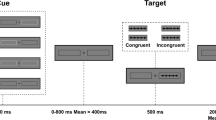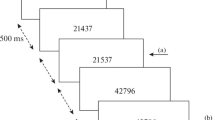Objective: To study the characteristics of event-related potentials in schizophrenia patients during solution of tasks involving the vigilance, orientation, and executive control attention networks depending on the severity of positive and negative symptomatology. Materials and methods. A total of 20 patients with schizophrenia took part in the study, of whom 10 had predominantly positive symptomatology and 10 had predominantly negative symptomatology. All patients were diagnosed with paranoid schizophrenia (F20.0). Attention functions were assessed using the Attention Networks Test with parallel recording of event-related potentials. Differences in the amplitude and latency of the N100 potential were analyzed on presentation of different types of cue, and the P300 potential was analyzed on identification of congruent and noncongruent flankers. Results and conclusions. Comparative analysis of the N100 potential in the absence of cues and on presentation of neutral stimuli demonstrated significantly lower amplitude and greater latency in the group of patients with predominantly negative symptomatology (Cz). Amplitudes of N100 event-related potentials on presentation of central and spatial cues were significantly greater in the group of patients with predominantly positive symptomatology. Analysis of P300 potentials in lead Fz on congruent and noncongruent stimuli established that there were no differences in the amplitudes of both stimuli in the group of patients with predominantly negative symptomatology; the amplitudes of event-related potentials were significantly greater to the congruent and noncongruent stimuli in the group with predominantly positive symptomatology. Opposite flanker responses were observed in the group of patients with predominantly positive symptomatology – P300 amplitude was significantly greater on presentation of the noncongruent stimulus. Specific characteristics were established for event-related potentials describing the features of attention systems such as vigilance, orientation, and executive control.
Similar content being viewed by others
References
B. A. Cornblatt, M. F. Lenzenweger, R. H. Dworkin, and L. Erlenmeyer-Kimling, “Positive and negative schizophrenic symptoms, attention, and information processing,” Schizophr. Bull., 11, No. 3, 397–408 (1985), https://doi.org/10.1093/schbul/11.3.397.
S. Frangou, T. Sharma, G. Alarcon, et al., “The Maudsley Family Study, II: Endogenous event-related potentials in familial schizophrenia,” Schizophr. Res., 23, No. 1, 45–53 (1997), https://doi.org/10.1016/S0920-9964(96)00089-8.
F. S. Galaverna, C. A. Morra, and A. M. Bueno, “Attention in patients with chronic schizophrenia: Deficit in inhibitory control and positive symptoms,” Eur. J. Psychiatry, 26, No. 3, 185–195 (2012), https://doi.org/10.4321/S0213-61632012000300005.
P. D. Harvey, D. Koren, A. Reichenberg, and C. R. Bowie, “Negative symptoms and cognitive deficits: what is the nature of their relationship?” Schizophr. Bull., 32, No. 2, 250–258 (2006), https://doi.org/10.1093/schbul/sbj011.
L. D. Vanes, E. Mouchlianitis, K. Patel, et al., “Neural correlates of positive and negative symptoms through the illness course: an fMRI study in early psychosis and chronic schizophrenia,” Sci. Rep., 9, No. 1, 14444 (2019), https://doi.org/10.1038/s41598-019-51023-0.
M. I. Posner and S. E. Petersen, “The attention system of the human brain,” Annu. Rev. Neurosci., 13, 25–42 (1990), https://doi.org/10.1146/annurev.ne.13.030190.000325.
J. Fan, B. D. McCandliss, T. Sommer, et al., “Testing the efficiency and independence of attentional networks,” J. Cogn. Neurosci., 14, No. 3, 340–347 (2002), https://doi.org/10.1162/089892902317361886.
K. Wang, J. Fan, Y. Dong, et al., “Selective impairment of attentional networks of orienting and executive control in schizophrenia,” Schizophr. Res., 78, No. 2–3, 235–241 (2005), https://doi.org/10.1016/j.schres.2005.01.019.
G. Orellana, A. Slachevsky, and M. Peña, “Executive attention impairment in fi rst-episode schizophrenia,” BMC Psychiatry, 12, 154 (2012), https://doi.org/10.1186/1471-244X-12-154.
P. G. Nestor, M. Kubicki, K. M. Spencer, et al., “Attentional networks and cingulum bundle in chronic schizophrenia,” Schizophr. Res., 90, No. 1–3, 308–315 (2007), https://doi.org/10.1016/j.schres.2006.10.005.
A. H. Neuhaus, C. Urbanek, C. Opgen-Rhein, et al., “Event-related potentials associated with Attention Network Test,” Int. J. Psychophysiol., 76, No. 2, 72–79 (2010), https://doi.org/10.1016/j.ijpsycho.2010.02.005.
C. D. Frith, “The positive and negative symptoms of schizophrenia reflect impairments in the perception and initiation of action,” Psychol. Med., 17, No. 3, 631–648 (1987), https://doi.org/10.1017/s0033291700025873.
M. Lijffijt, S. D. Lane, S. L. Meier, et al., “P50, N100, and P200 sensory gating: relationships with behavioral inhibition, attention, and working memory,” Psychophysiology, 46, No. 5, 1059–1068 (2009), https://doi.org/10.1111/j.1469-8986.2009.00845.x.
A. Laurent, L. Garcia-Larréa, T. d’Amato, et al., “Auditory event-related potentials and clinical scores in unmedicated schizophrenic patients,” Psychiatry Res., 86, No. 3, 229–238 (1999), https://doi.org/10.1016/s0165-1781(99)00038-4.
D. A. Kaufman, C. N. Sozda, V. M. Dotson, and W. M. Perlstein, “An event-related potential investigation of the effects of age on alerting, orienting, and executive function,” Front. Aging Neurosci., 8, 99 (2016), https://doi.org/10.3389/fnagi.2016.00099.
C. J. Simons, A. Sambeth, L. Krabbendam, et al., “Auditory P300 and N100 components as intermediate phenotypes for psychotic disorder: familial liability and reliability,” Clin. Neurophysiol., 122, No. 10, 1984–1990 (2011), https://doi.org/10.1016/j.clinph.2011.02.033.
Author information
Authors and Affiliations
Corresponding author
Additional information
Translated from Zhurnal Nevrologii i Psikhiatrii imeni S. S. Korsakova, Vol. 122, No. 2, pp. 88–96, February, 2022.
Rights and permissions
Springer Nature or its licensor (e.g. a society or other partner) holds exclusive rights to this article under a publishing agreement with the author(s) or other rightsholder(s); author self-archiving of the accepted manuscript version of this article is solely governed by the terms of such publishing agreement and applicable law.
About this article
Cite this article
Pultsina, K.I., Alekhin, A.N., Petrova, E.V. et al. Effectiveness of Attention Networks and the Severity of Positive and Negative Symptomatology in Schizophrenia. Neurosci Behav Physi 52, 878–885 (2022). https://doi.org/10.1007/s11055-022-01312-5
Received:
Accepted:
Published:
Issue Date:
DOI: https://doi.org/10.1007/s11055-022-01312-5




